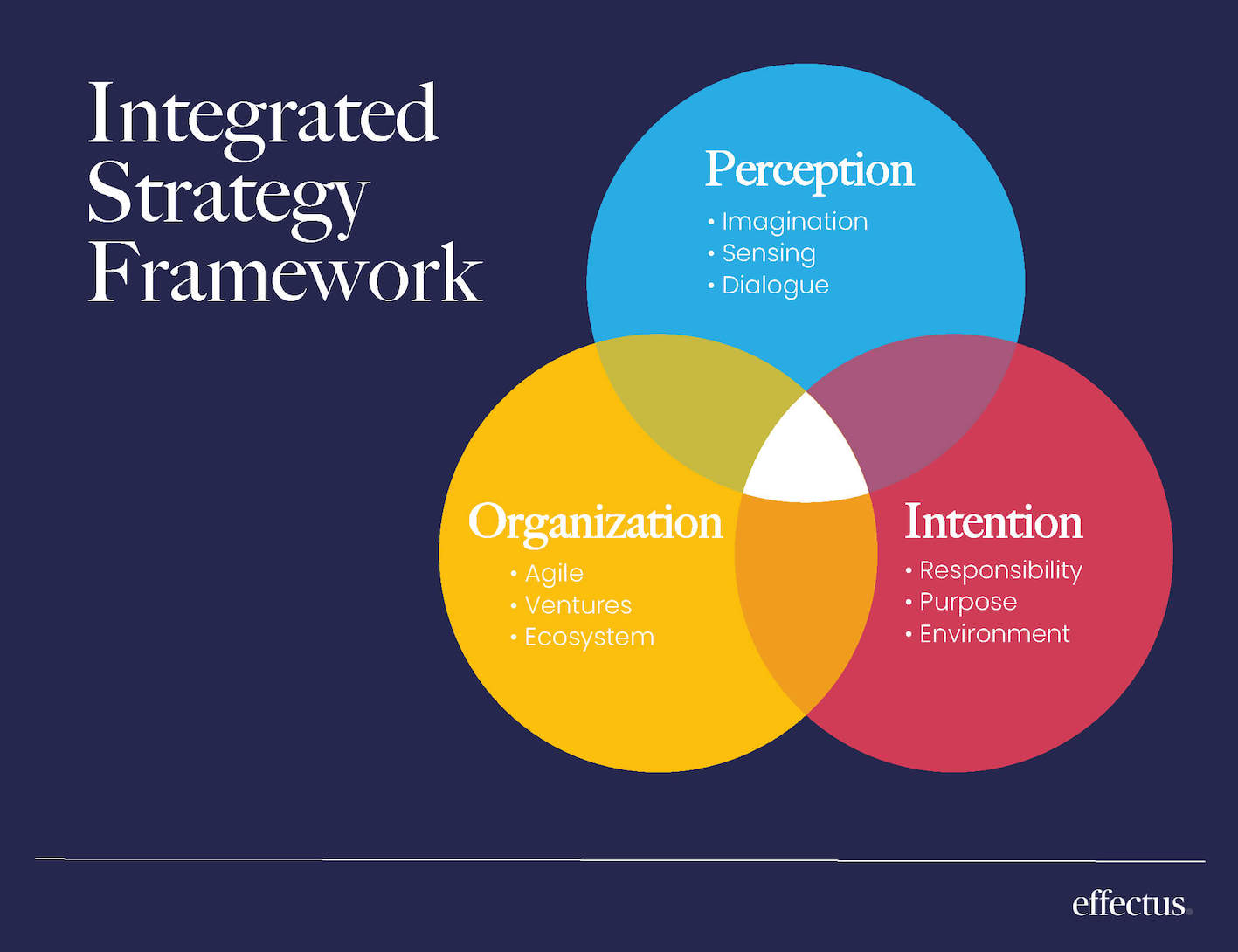Integrated Strategy
A Multidimensional Approach to Strategy Capability
How integrated is your strategy?
It’s a good time to be a business strategist. Strategy is in a period of renewal. New practices are being invented to deal with new market conditions, more people are getting involved in strategy, and the positive social impact of the strategy is on the rise. Strategy has not been this productive since the 1980’s when Michael Porter and CK Prahalad created the strategic tools and vocabulary that continue to shape the development of business strategies around the world.
This renaissance of strategy also brings a new challenge. Increased scope and participation in strategy processes increases the risk of overload involving multiple strategic actors and objectives. The challenge is to integrate the new factors and players in strategy into a coherent approach in which each factor enriches the other. The result is a capability in strategy that is ‘fit for purpose’ in the 2020’s.
What’s changing?
Strategic planning, often criticized as a relic of the industrial era, is gradually moving away from a centrally driven annual budgeting exercise to a more continuous, distributed, issue-based, process.
Leading companies are finding ways to reconcile their need for accountability and resource allocation with the flexibility required to operate in complex competitive environments. New techniques like strategic options and ‘StratOps’ provide building blocks for a new agile approach to planning.
At the same time, the process of strategy formulation is moving out of the boardroom and into the broader organization and beyond. Leading companies are using large scale participative processes to draw insights from all corners of their operations and engage colleagues directly into the strategy process. They are also exploiting the power of data and algorithms to gain deeper insights into customer behaviour and combining this with pricing and business model experimentation platforms to formulate and rapidly test strategic hypotheses and value propositions.

Fundamentally, shareholder value is gradually giving way to stakeholder value as the highest order strategic objective, encompassing people, planet and profit. Leading companies are developing expertise in reframing the trade-offs between financial and non-financial objectives and leveraging purpose to boost enterprise engagement.
All these changes are welcome and offer boards and executives an opportunity to step-change strategic performance and relevance. However, the challenge is ensuring that the new factors in strategy are effectively integrated into a coherent framework rather than an assortment of scattered commitments and projects. In our current work with clients on this journey, we use the following framework to manage three major dimensions of strategy and synergy between them:

Perception
‘Perception’ is about sharpening the strategy instincts of the leadership team by raising their collective imagination, foresight, and dialogue skills. Research has shown that most large corporates fail over the medium term because of the inability of their senior leadership team to, literally, change their minds. New techniques help to reveal what CK Prahalad called, ‘dominant logic’, the sub-conscious filters that predispose leaders to perceive certain data as important and disregard other data. Analogical thinking and machine-assisted learning are being used to stretch and augment the perceptual capabilities of the leadership group. When all of these are combined with effective senior team dialogue, the level of improvement in strategic discussion and judgement is dramatic.
Organization
‘Organization‘ includes new ways of structuring the enterprise to simultaneously drive strategic discovery and superior execution, for example, agile teams, corporate ventures & scaleups, and ecosystem relationships. These new practices are cognitive tactics as much as they are organizational innovations, enabling a customer–centric orientation and increasing the diversity of ideas. Structure follows strategy is no longer the case when the organization becomes the source of insights and growth opportunity.
Intention
Intention is the social dimension of strategy. Companies and investors are becoming more comfortable with a holistic concept of value including value for customers, employees, society, the environment, and shareholders. Good strategy is now responsible strategy. Strategists are developing expertise in new models and metrics to build responsible strategies including shared value, ESG, and circularity.

Where is Integrated Strategy being applied today?
We currently find integrated strategy being applied in two situations. Firstly, business transformation and renewal, where there is a need for radical, imaginative thinking around the business model combined with a strong shared purpose and organizational agility to execute change. Secondly, the circular economy, where there is a need for innovative operational change based on commitment to stakeholder value and an understanding of ecosystem dynamics. In both these cases, integrated strategy delivers far superior solutions than the limited, one-dimensional, plan-then-implement models of the past.
For a CEO and Chief Strategy Officer, integrated strategy offers a way of unifying strategic initiatives across the firm. The trend toward greater participation in strategy has led to strategic responsibilities being extended to multiple actors, for example, the Transformation Office, Sustainability Office, Digital Office, People Office, Innovation Unit, etc. The risk is strategy overload – a patchwork of important but disconnected strategic initiatives that cause politicking and confusion. This is both a governance and effectiveness problem. Too much strategy is bad strategy.
An integrated approach solves the problem by connecting the three major factors and driving creative convergence between them: leadership’s ability to perceive strategic opportunities is enhanced by agile organizational structures and informed by moral perspective; performance management systems support strategic discovery and elevate responsible priorities; shared intention increases organizational cohesion and differentiated positioning. Managing the three factors as one capability delivers better outcomes in each area and provides a better chance of sustainable value creation, which is and has always been, the essence of strategy.
In subsequent articles we will explain more about each dimension of integrated strategy and ways to implement the approach.
Acknowledgements
Integrated strategy builds on ideas from leaders in the field of strategy research, notably:
- Professor Yves Doz and Dr Keeley Wilson of INSEAD Business School – ‘strategic agility‘
- Martin Reeves, BCG Henderson Institute – ‘strategy stack‘
- Gunter Mueller–Stewens, St Gallen University – ‘normative strategy‘
- Gordon Hewitt, New Game Academy – ‘new game thinking‘
- Richard Whittington, Oxford Business School – ‘opening strategy‘
Contact Us
Let us know your situation and we can discuss how we can benefit your organization’s strategy planning.
